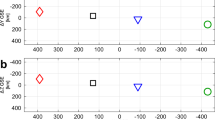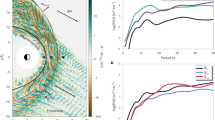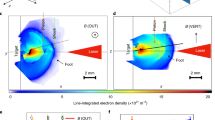Abstract
Plasma waves are a characteristic feature of shocks in plasmas, and are produced by non-thermal particle distributions that develop in the shock transition layer. The electric fields of these waves have a key role in dissipating energy in the shock and driving the particle distributions back towards thermal equilibrium1. Here we report the detection of intense plasma-wave electric fields at the solar wind termination shock. The observations were obtained from the plasma-wave instrument on the Voyager 2 spacecraft2. The first evidence of the approach to the shock was the detection of upstream electron plasma oscillations on 1 August 2007 at a heliocentric radial distance of 83.4 au (1 au is the Earth–Sun distance). These narrowband oscillations continued intermittently for about a month until, starting on 31 August 2007 and ending on 1 September 2007, a series of intense bursts of broadband electrostatic waves signalled a series of crossings of the termination shock at a heliocentric radial distance of 83.7 au. The spectrum of these waves is quantitatively similar to those observed at bow shocks upstream of Jupiter, Saturn, Uranus and Neptune.
This is a preview of subscription content, access via your institution
Access options
Subscribe to this journal
Receive 51 print issues and online access
$199.00 per year
only $3.90 per issue
Buy this article
- Purchase on Springer Link
- Instant access to full article PDF
Prices may be subject to local taxes which are calculated during checkout




Similar content being viewed by others
References
Gurnett, D. A. & Bhattacharjee, A. Introduction to Plasma Physics 277–278 (Cambridge Univ. Press, Cambridge, UK, 2005)
Scarf, F. L. & Gurnett, D. A. A plasma wave investigation for the Voyager mission. Space Sci. Rev. 21, 289–308 (1977)
Tonks, L. & Langmuir, I. Oscillations in ionized gases. Phys. Rev. 33, 195–210 (1929)
Stix, T. H. The Theory of Plasma Waves 10 (McGraw-Hill, New York, 1962)
Gurnett, D. A. & Kurth, W. S. Electron plasma oscillations upstream of the solar wind termination shock. Science 309, 2025–2027 (2005)
Stone, E. C. et al. Voyager 1 explores the termination shock region and the heliosheath. Science 309, 2017–2020 (2005)
Washimi, H. et al. A forecast of the heliospheric termination-shock position by three-dimensional MHD simuluations. Astrophys. J. 670, L139–L142 (2007)
Kurth, W. S., Gurnett, D. A. & Decker, R. B. in The Physics of the Inner Heliosheath: Voyager Observations, Theory, and Future Prospect (5th Annu. IGPP Internat. Astrophys. Conf.) (eds Heerikhuisen, J., Florinski, V., Zank, G. P. & Pogorelov, N. V.) 116–121 (American Institute of Physics, Melville, New York, 2006)
Burlaga, L. F. et al. Magnetic fields at the solar wind termination shock. Nature 10.1038/nature07029 (this issue)
Richardson, J. D. et al. Cool heliosheath plasma and deceleration of the upstream solar wind at the termination shock. Nature 10.1038/nature07024 (this issue)
Decker, R. B. et al. Mediation of the solar wind termination shock by non-thermal ions. Nature 10.1038/nature07030 (this issue)
Stone, E. C. et al. An asymmetric solar wind termination shock. Nature 10.1038/nature07022 (this issue)
Kurth, W. S. & Gurnett, D. A. Plasma waves as indicators of the termination shock. J. Geophys. Res. 98, 15129–15136 (1993)
Gurnett, D. A. et al. First plasma wave observations at Neptune. Science 246, 1494–1498 (1989)
Fredricks, R. W., Kennel, C. F., Scarf, F. L., Crook, G. M. & Green, I. M. Detection of electric-field turbulence in the Earth’s bow shock. Phys. Rev. Lett. 21, 1761–1764 (1968)
Moses, S. L., Coroniti, F. V., Kennel, C. F., Kurth, W. S. & Gurnett, D. A. Comparison of plasma wave measurements in the bow shocks at Earth, Jupiter, Saturn, and Jupiter. Geophys. Res. Lett. 17, 1653–1656 (1990)
Lembege, B. et al. Selected problems in collisionless-shock physics. Space Sci. Rev. 110, 161–226 (2004)
Scholer, M., Shinohara, I. & Matsukiyo, S. Quasi-perpendicular shocks: Length scale of the cross-shock potential, shock reformation, and implication for shock surfing. J. Geophys. Res. 108 10.1029/2002JA009515 (2003)
Filbert, P. C. & Kellogg, P. J. Electrostatic noise at the plasma frequency beyond the Earth’s bow shock. J. Geophys. Res. 84, 1369–1381 (1979)
Bridge, H. S. et al. The plasma experiment on the 1977 Voyager mission. Space Sci. Rev. 21, 259–287 (1977)
Krimigis, S. M. et al. The low energy charged particle (LECP) experiment on the Voyager spacecraft. Space Sci. Rev. 21, 329–354 (1977)
Acknowledgements
We wish to thank L. Burlaga and J. Richardson for discussions regarding the magnetometer and plasma data in advance of publication. The research at the University of Iowa was supported by NASA through the Jet Propulsion Laboratory.
Author Contributions D.A.G. is the principal investigator for the Voyager plasma-wave instruments and led the analysis. W.S.K. is the co-investigator and identified the wave signatures.
Author information
Authors and Affiliations
Corresponding author
Rights and permissions
About this article
Cite this article
Gurnett, D., Kurth, W. Intense plasma waves at and near the solar wind termination shock. Nature 454, 78–80 (2008). https://doi.org/10.1038/nature07023
Received:
Accepted:
Issue Date:
DOI: https://doi.org/10.1038/nature07023
This article is cited by
-
Observations of the Outer Heliosphere, Heliosheath, and Interstellar Medium
Space Science Reviews (2022)
-
Plasma densities near and beyond the heliopause from the Voyager 1 and 2 plasma wave instruments
Nature Astronomy (2019)
-
Two sides of the heliopause
Science China Earth Sciences (2011)
-
Physics of the Solar Wind–Local Interstellar Medium Interaction: Role of Magnetic Fields
Space Science Reviews (2009)
Comments
By submitting a comment you agree to abide by our Terms and Community Guidelines. If you find something abusive or that does not comply with our terms or guidelines please flag it as inappropriate.



